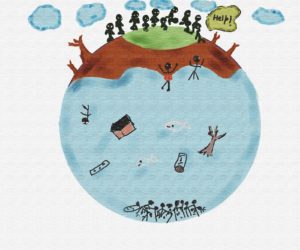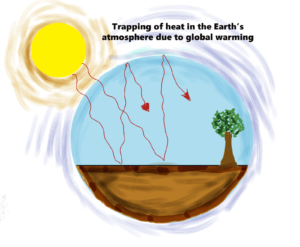Assessing climate change is an essential endeavour in our quest to comprehend and address one of the most pressing challenges of our time. As our planet undergoes profound transformations, driven by the warming of the Earth’s atmosphere due to human activities, it becomes paramount to measure, analyze, and interpret the shifts in our climate system. From the monitoring of temperature trends and the analysis of greenhouse gas concentrations to the study of melting ice caps and shifting weather patterns, assessing climate change requires a multidisciplinary approach and a wealth of scientific data. In this exploration, we embark on a journey to understand the methodologies and insights that enable us to gauge the extent of climate change, anticipate its consequences, and forge pathways towards a more sustainable future for all.
Climate change is a topic that we like to discuss and a topic that we regularly see being discussed in different forms of media. During your geography examination, you will more than likely be asked several different questions about climate change.
The Evidence
When we talk about climate change, we are not simply referring to current global warming. We are also referring to the drastic changes in global temperature that have occurred over the past 2 million years. Our most recent geological time period is something that we refer to as the Quaternary period, and we have seen a lot of shifts during it.
When we talk about temperature shifts over this time period, we are actually talking about glacial periods and interglacial periods. The former tend to last for around 100,000 years, while the latter are much briefer. We have gone 15,000 years since the last glacial period, which is one of the reasons we can see the earth warming.
Having said that, there are a few other ways that we can see climate change occurring. They include:
Reviewing Temperature Records
People have been tracking temperatures around the world for well over a century. They were also noted before that point, but the fact that thermometers were not readily available means that the measurements could be unreliable. We can use these to see how temperatures are shifting.
Analysing Pollen and Studying Tree Rings
You probably already know that we can use the rings in a tree to determine how old it is, but did you know that we can also use them to show us what conditions were like over that year? The thickness of the ring shows us what the climate was like and we can use this information to track climate change because of how old some of the trees that scientists study are.
Scientists can also study pollen that has become trapped in sediment. They can identify how old it is and what species of plant it is from. With this information, scientists can compare what they find to plants that exist today to see what conditions they needed to grow.
Using Ice and Sediment Cores
Have you ever seen scientists drilling into ice sheets? This is usually done because of the layers that ice sheets are formed of as it takes an entire year for one sheet to form. This means that each additional layer is older than the last, and each layer is home to some unique trapped gases. These can be used to determine what the temperature was.
Recent trends to find evidences
The recent warming trend is important to note because most of it is due to the result of human activities since the middle of 20th century.
Satellites orbiting the Earth and other technological innovations allow scientists to analyse the big picture, collecting different types of data about our planet and its climate on a global scale.
In the 19th century, the heat-trapping nature of CO2 and other gases was demonstrated. There is no doubt left that increased levels of greenhouse gases cause the warming of the Earth.
Evidence in nature shows that climate change is real and not some theory made by scientists.
- Ancient evidence – Studies in which tree rings, ocean sediments, coral reefs, and sedimentary rocks were used reveal that contemporary warming is occurring at a ten times faster rate than the average rate in the time of ice age.
- Global rise in temperature – Rise in average temperature = 1.62 degree fahrenheit ( 0.9 degree Celsius) since 19th century. warmest year = 2016.
- Warming oceans – There is rise in temperature of oceans by 0.4 degree since 1969.
- Shrinking ice sheets – There is a gradual decrease in the ice sheets of the Greenland and Antarctic. according to data from NASA’s Gravity Recovery and Climate Experiment, Greenland lost an average of 281 billion tonnes of ice per year between 1993 and 2016. Similarly, Antarctica lost about 119 billion tons during the same time period. This rate of melting has tripled in the last decade.
Other factors that show climate change are:
- Glacial retreat
- Ocean acidification
- Prevalence of extreme temperatures
- Rise in sea level
What Causes Climate Change?
Climate change is the result of natural and man-made activities. Natural factors are not major factors that contribute to climate change. We humans are mainly responsible for climate change.
Man-made factors leading to warming
- Burning of fossil fuels – We are running our industries, and transportation activities and even at home we use fossil fuels like petrol, diesel, natural gas etc. which emit carbon dioxide and other greenhouse gases into the atmosphere leading to the warming of the earth.
- Deforestation – Cutting off trees leads to less absorption of CO2 which further traps the heat inside the earth’s atmosphere.
- Dumping waste in landfills – A large amount of methane is produced when waste dumped in landfills decomposes which also contribute to warming of the earth.
- Agriculture – An increase in agriculture means a decrease in the land for forests and trees. Further, agricultural practices lead to a large amount of nitrogen oxides being released in the atmosphere.
Natural factors that cause warming
- Volcanic activities – Volcanoes release a large amount of carbon dioxide in the atmosphere.
- Earth’s orbital cycle – Milankovitch cycle refers to the variations in the tilt and orbit of Earth around the Sun which causes natural warming and cooling periods on Earth.
- Sun as the heat source – The Sun is the ultimate source of energy and heat and the radiations emitted by it vary sometimes. More radiation will lead to more heating of the atmosphere.
Impact of Climate Change on the UK
Positive impacts
- Many crops like peaches, oranges, and apples which were not grown in the UK before can be grown in the UK.
- There is less burden to heat the room temperatures because the environment itself is a bit warm.
- Better transportation system and fewer accidents due to less extreme winters which block the transport activities to some extent.
Negative impacts
- It is likely that the rise in sea level will severely affect the people living in coastal areas. In Fact, some coastal areas are already experiencing extreme storms, floods and coastal erosion due to the rise in sea level.
- The destruction of a lot of economy for people who live in these areas. Also, it affects the access to quality of goods and services.
- Occurrence of droughts and floods.
- Shortage of potable water.
Frequently Asked Questions on Assessing Climate Change
What are the primary indicators of climate change, and how do scientists measure and monitor them?
Indicators include rising temperatures, sea level changes, ice melt, and shifts in precipitation patterns. Scientists use instruments, satellites, and climate models for monitoring.
Explain the concept of greenhouse gases and their role in causing global warming.
Greenhouse gases trap heat from the sun in the Earth’s atmosphere, leading to the greenhouse effect and an increase in global temperatures.
What are some of the observed impacts of climate change on ecosystems, weather events, and sea levels?
Impacts include more frequent extreme weather events, altered ecosystems, rising sea levels, and disruptions to agriculture and water resources.
Describe the international efforts and agreements aimed at mitigating climate change and reducing greenhouse gas emissions.
International agreements like the Paris Agreement aim to limit global warming by setting emission reduction targets and fostering cooperation among nations.
How can individuals and communities contribute to climate change mitigation and adaptation efforts in their daily lives?
Actions include reducing energy consumption, using renewable energy sources, conserving water, reducing waste, and supporting sustainable practices.







